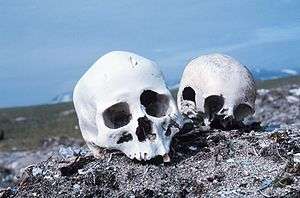Forensic biology
| Part of a series on |
| Forensic science |
|---|
 |
|
Forensic biology is the application of biology to law enforcement.
It includes the subdisciplines of forensic anthropology, forensic botany, forensic entomology, forensic odontology, forensic toxicology and various DNA or protein based techniques.
Applications
Forensic biology has been used to prove a suspect was at a crime scene, identify illegal products from endangered species,[1] solve crimes by matching crime scene evidence to suspects,[1] investigate airplane bird strikes,[1][2] and investigate bird collisions with wind turbines.[2]
Disciplines
Forensic anthropology
Forensic anthropology is for identification and recovery of remains. In extreme cases where conventional techniques are unable to determine the identity of the remains, anthropologists are sometimes able to deduce certain characteristics based on the skeletal remains. Race, sex, age and stature can often be determined by both measuring the remains and looking for structural clues in the bones.
Forensic botany
A Forensic botanist looks to plant life in order to gain information regarding possible crimes. Leaves, seeds and pollen found either on a body or at the scene of a crime can offer valuable information regarding the timescales of a crime and also if the body has been moved between two or more different locations. The forensic study of pollen is known as forensic palynology and can often produce specific findings of location of death, decomposition and time of year. The knowledge of systematics leads to identification of evidences at crime scene. The morphological and anatomical study revels in collection of samples from crime scene and its in vitro analysis. It leads to proper submission of evidences in court of law.
Forensic ornithology
Bird remains can be identified, first and foremost from feathers (which are distinctive to a particular species at both macroscopic and microscopic levels).
Forensic odontology
Odontologists or dentists can be used in order to aid in an identification of degraded remains. Remains that have been buried for a long period or which have undergone fire damage often contain few clues to the identity of the individual. Tooth enamel, as the hardest substance in the human body, often endures and as such odontologists can in some circumstances compare recovered remains to dental records.
Forensic toxicology
Forensic toxicology is the use of toxicology and other disciplines such as analytical chemistry, pharmacology and clinical chemistry to aid medical or legal investigation of death, poisoning, and drug use. The primary concern for forensic toxicology is not the legal outcome of the toxicological investigation or the technology utilized, but rather the obtainment and interpretation of results.
DNA-based techniques
DNA-based evidence has become a significant tool that many law enforcement investigators now have at their disposal. DNA evidence can definitively link a suspect to either a crime scene or victim. Nuclear DNA evidence has been recovered from blood, semen, saliva, skin cells and hair. Furthermore, Mitochondrial DNA can be recovered from both bone and teeth dating back thousands of years. Laboratory analysis of DNA evidence generally involves the sample being amplified and quantified by a form of the Polymerase chain reaction known as Quantitative PCR or qPCR. (PCR) amplification of any sample recovered followed by sequencing via Capillary electrophoresis in order to obtain a DNA profile which can be compared to suspect DNA.
DNA can also be extracted from animals and used to at least identify the species, for example bird or bat remains on an airplane or wind turbine.[2]
Popular culture
In popular culture, forensic biology is frequently portrayed in shows like Law & Order, Bones, CSI, Dexter and Castle.
See also
References
- 1 2 3 "Roxie C. Laybourne, 92; Pioneer in Forensic Ornithology Aided Aviation", Los Angeles Times, p. in print edition B-9, August 18, 2003
- 1 2 3 Matthew L. Wald (January 24, 2009), "Identifying the Bird, When Not Much Bird Is Left", New York Times
External links
- bio-forensics.com, bioFORENSICS - Tools for forensic identification